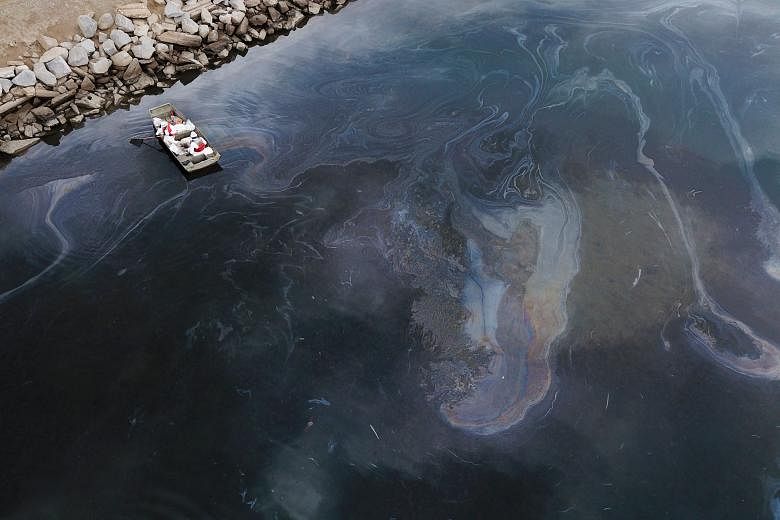LOS ANGELES (REUTERS) - The US Coast Guard and a pipeline executive were questioned sharply on Tuesday (Oct 5) about the response time to a massive oil spill that fouled Southern California beaches and killed wildlife.
As miles of beaches remained closed after roughly 3,000 barrels of oil were spilled into the Pacific Ocean, officials defended themselves at a news conference. They said it was Saturday morning before pipeline operator Amplify Energy Corp detected the leak.
A "good Samaritan" first reported an oil sheen on the water's surface to authorities on Friday night, but that information was "inconclusive," US Coast Guard Captain Rebecca Ore told reporters at the news conference. Satellite imagery from the federal government's National Oceanic and Atmospheric Administration confirmed the presence of oil in the water hours later, Ore added.
Tom Umberg, a state Senator who represents the coastal region, said at the news conference that officials needed to explain why the response was delayed and whether the pipeline had been adequately inspected.
"It's very difficult for us to understand how this could occur," he said.
The oil appears to have leaked through a 13-inch gash in the pipe, which was "pulled like a bowstring" about 105 feet from where it should have been, Martyn Willsher, chief executive of drilling company Amplify Energy said at the news conference.
Amplify owns the pipeline and connected rigs.
The movement of the 4,000-foot section of the 17.7-mile pipeline was discovered by divers and remotely operated vehicles, according to an update by federal, state and company officials.
Huntington Beach, about 65 km south of Los Angeles, had 34 square km of ocean and portions of its coastline "covered in oil," said Mayor Kim Carr. The town, which advertises itself as Surf City USA, is one of the rare places in Southern California where oil platforms are visible from the beach.
Angry residents blasted what they called a slow initial response to the spill. Already, one lawsuit has been filed against Amplify by a local DJ, Peter Moses Gutierrez Jr.
Willsher refused to speculate on the cause of the spill, a day after he suggested an undersea pipeline may have been damaged by a ship's anchor.
"I'm not here to speculate about the cause. There will be a full investigation," he said. "Obviously the pipeline has been displaced. It's a 16-inch steel pipeline that's a half inch thick and covered in an inch of concrete. For it to be moved 105 feet is not common."+

The pipeline runs along the ocean floor from the Elly platform, about 14.5 km offshore in 77m of water, then heads toward port. On Tuesday, the US Department of Transportation said the entire pipeline should remain shut until ordered to be reopened.
On Tuesday, Ore said she had "no confirmation" that a vessel was above where the pipeline sits.
Ships in record numbers have jammed the port complex near the oil spill, according to port data.
An anchor strike is a plausible explanation, said two former Amplify employees who asked not to be named. They noted that anchor strikes have dented or scratched offshore pipelines before.
There were more anchors in the area due to supply chain bottlenecks as consumer demand has rebounded from the depths of the pandemic.
As of Tuesday morning, there were 63 container ships in San Pedro Bay waiting to unload at the ports of Los Angeles and Long Beach, according to the Marine Exchange of Southern California. On Sept 19, a Covid-era record 97 ships were backed up.

Prior to the pandemic, there was typically no more than one container ship at anchor in the bay, according to Captain Kip Louttit of the Marine Exchange, who added that anchorages around the port have been full for the last year.
"All ships were anchored where they were supposed to be," Louttit said of the vessel backup.
Environmental watchdog group SkyTruth said satellite imagery from Oct 1, the day before the spill was reported, shows cargo ships anchored near the area where the pipeline runs, according to government maps. The closest, however, was about 450 meters away from the pipeline, SkyTruth President John Amos said.
"That seems like a comfortably long distance to separate that pipeline from that ship, but one thing I don't know is how accurate is this government data on exactly where this pipeline sits on the seafloor," Amos said in an interview.

